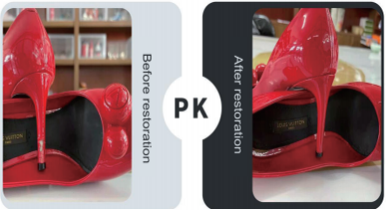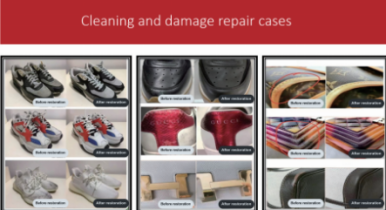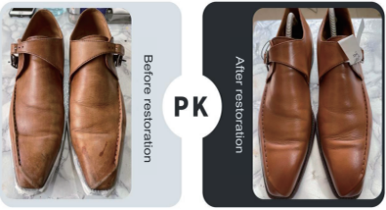Edit Content
First, cleaning methods of shoes made of different materials
Pretreatment: use a soft brush or dry cloth to gently remove surface dust and loose dirt.
Special cleaner: Choose leather cleaner with neutral pH value, and gently clean it in circles with a slightly wet sponge.
Treatment of stubborn stains: corn starch can be used for oil stains, and white vinegar diluent can be used for light wiping for salting.
Natural drying: dry in the shade in a ventilated place, away from direct heat source (leather will harden and crack when heated).
Nursing stage: after completely drying, use shoe polish or shoe milk that matches the color of the shoes for maintenance.
Daily maintenance: Use a special suede brush to brush lightly along the fluff direction.
Decontamination method: slight stains can be lightly wiped with an eraser, and stubborn stains can be cleaned with a special cleaner for suede.
Waterproof treatment: after cleaning, spray professional waterproof spray (spray evenly at a distance of 20cm).
Precautions: Never wash with water, as water will lead to hardening and discoloration of fluff.
Detachable parts: Take out shoelaces and insoles and clean them separately.
Gentle washing: Brush with soft brush and neutral detergent (recommended ratio is 1:10 dilution).
Instructions for machine washing: Only some materials can be machine-washed, so you need to put them in a laundry bag to choose soft mode.
Drying skills: Insert absorbent white paper or special shoe braces into the shoes to prevent deformation.
Pretreatment: use a dry toothbrush to remove the dirt on the rubber part of the shoe edge.
Immersion cleaning: cold water mixed with a small amount of oxygen bleach (to avoid chlorine bleaching) is immersed for 15 minutes.
Detail treatment: baking soda paste (baking soda+water) can effectively remove the yellowing of canvas.
Air drying method: air drying upside down to avoid water stains and exposure to prevent rubber soles from aging.
Second, the daily maintenance and professional repair
Daily maintenance schedule

Professional repair service selection
Sole replacement: When the sole is worn to 50%, it should be replaced. The common price range is 80-300 yuan.
Upper repair: professional color patching service can repair 90% scratches and wear, and the cost is about 50-200 yuan.
Plastic service: deformed shoes can be restored to their original state through heat setting technology, and the effect can last for 3-6 months.
Luxury care: professional care for high-end brand shoes, including material identification and original factory process repair.
Family simple repair skills
Open the sole: use special shoe glue (such as Nanguang resin glue) and press and fix it for 24 hours.
Scratch treatment: the scratches of light leather shoes can be filled with the same color crayons and polished.
Heel wear: nail polish or special heel patch can be used as temporary remedy.
Odor elimination: baking soda+activated carbon package can absorb more than 85% of odor overnight.
Three, seasonal storage and special care
Key points of seasonal storage
Cleaning preparation: It must be thoroughly cleaned and completely dried before storage.
Moisture-proof measures: put silica gel desiccant in the shoe box (about 20g for each pair of shoes).
Stereotype protection: Use shoe braces or bubble-filled paper to keep the shoe shape.
Storage environment: the ideal temperature is 15-25℃ and humidity is 40-60%, away from direct sunlight.
Special material nursing
Patent leather shoes: only need to be wiped with a slightly damp cloth to avoid any oily care products (which will cause fog).
Mesh sneakers: toothbrush+neutral lotion for gentle brushing, and the water pressure should not be too high.
Wool/tweed shoes: Special cloth cleaner is used for local treatment to avoid overall soaking.
Metal decorative shoes: dip a cotton swab in a small amount of alcohol to clean the metal parts and dry them immediately.
Fourth, professional answers to frequently asked questions
Q: What should I do if my new shoes rub my feet?
A: The professional scheme is divided into three steps: 1) heating the foot-grinding part with a hair dryer and spreading it with thick socks; 2) Apply special anti-wear paste; 3) Use silicone anti-wear paste for protection. Usually it can fit naturally after 3-5 times wearing.
Q: How to thoroughly clean the yellow edges of white shoes?
A: Mix 1:1 hydrogen peroxide and baking soda to make a paste, apply it to the yellow part for 2 hours and then brush it. Professional deoxidizer can be used for severe oxidation, and anti-UV protective layer can be sprayed after treatment.
Q: What should I do if my shoes get wet?
A: four steps of immediate action: 1) absorbing surface moisture; 2) Absorbent paper (replaced every 2 hours); 3) natural drying in a ventilated place; 4) Nursing after completely drying. Never use heat source to accelerate drying.
Q: How to judge whether shoes are worth repairing?
A: Consider three factors: 1) Whether the repair cost is lower than 40% of the price of new shoes; 2) Whether the sole structure is intact; 3) Evaluation of emotional value. High-grade leather shoes are usually worth repairing many times.
Through scientific care methods and timely professional repair, the life of high-quality shoes can be extended by 3-5 times. It is suggested to establish nursing files for each pair of shoes, record cleaning and maintenance time, and form systematic nursing habits. When you encounter any injury that cannot be handled by yourself, consult a professional shoe repair organization in time to avoid irreversible damage caused by improper handling.



© 2025 AGTG